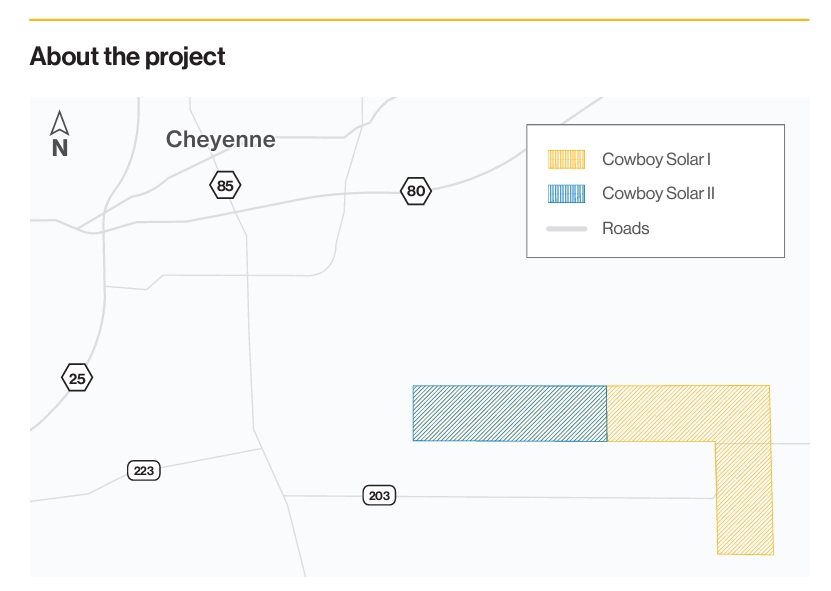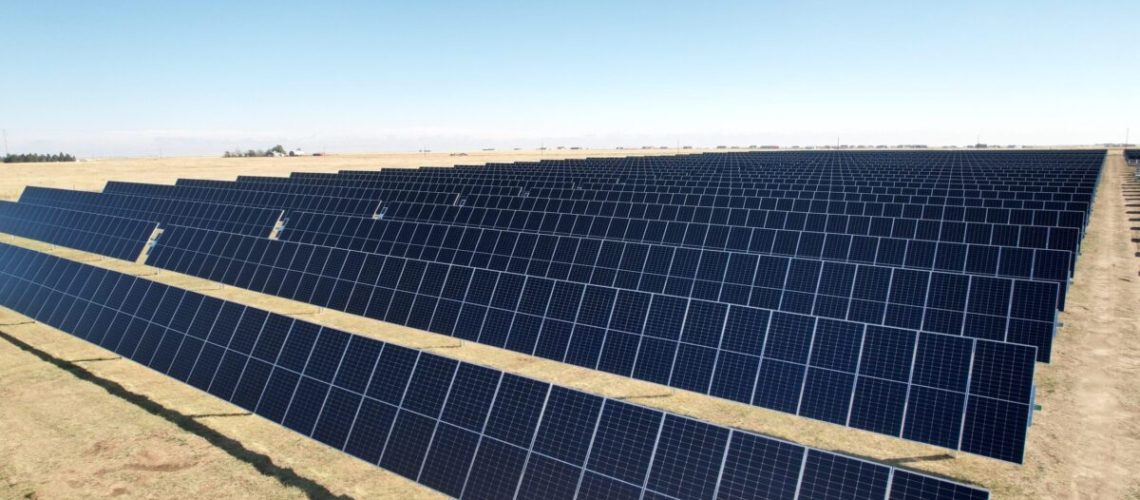The $1.2 billion Cowboy solar project will be built by Enbridge, with 771 MW expected to be fully operational by 2027.
Wyoming ranked 50th in installed solar in 2023, according to the Solar Energy Industries Association (SEIA) with only 124 MW installed. As of Q4 2023, SEIA expected it to pop up to 43rd place with 685 MW expected to be installed over the next five years. However, the Cowboy Solar Project, at 771 MW and 268 MW of battery energy storage, will surpass that in one fell swoop.
The Cowboy project was just approved by Wyoming’s Industrial Siting Council, and developer Enbridge plans construction in two phases with both beginning in March 2025. Commercial operation of Phase 1, which will include 400 MW of solar and 136 MW battery energy storage system (BESS) is expected in January 2027. Commercial operation of Phase II with 371 MW solar and 133 MW BESS is expected to begin in August 2027. The company estimates that the onsite workforce will have average of 285 temporary workers monthly, with a peak workforce of approximately 375 workers in April 2025.
For more on the process of obtaining permits for large-scale renewable energy project in Wyoming, read Early engagement avoids perils of Wyoming industrial siting.
The combined 771 MW of solar is estimated to be enough to serve 771,000 homes, or more than three times the number of homes in Wyoming. Enbridge has not yet announced an offtake agreement for the electricity generated.
Enbridge, a Canadian multinational pipeline and energy company headquartered in Calgary, Alberta, Canada, intends to build the project about 4 miles south of Cheyenne on 3,845 acres of private land that it will lease.

While the company reports that it is currently responsible for moving about 30% of the crude oil produced in North America and 20% of the natural gas consumed in the United States, the company says it has committed to reducing emissions 35% by 2030 and being net-zero by 2050. It has a portfolio of over 5.2 GW of wind, offshore wind and solar projects in Canada, the U.S., France, Germany and England.
To keep the public informed about the massive Wyoming project, Enbridge held public meetings to notify neighbors within 1 km of the project in October 2023, which were advertised in the local newspaper, the Wyoming Tribune Eagle. The company said it is planning further engagement with broader public notification and outreach to community stakeholders and Tribal communities as the project gets closer to the 2026 in-service date. Details of future outreach will be posted here.
(Read Opposition stymies solar—sometimes)
Approval by the Industrial Siting Council is just the first step in the process, as Enbridge must also obtain permits from Laramie County as well as necessary environmental and municipal permits required before constructing the project.
Once operational, the Cowboy solar project will be just the third utility-scale solar installation in the state. In April Southern Power, a wholesale energy provider and subsidiary of Southern Company, announced the operation of the 150 MW South Cheyenne Solar Facility, currently the largest in Wyoming. Southern Power acquired the project from Qcells USA, which had served as the project developer, module manufacturer and engineering procurement construction (EPC) provider of the site. Cheyenne Light, Fuel and Power signed a 20-year power purchase agreement for the electricity generated, which will be used to provide renewable energy to a data center customer.
Prior to the South Cheyenne facility, the largest was the Sweetwater solar project, a 98 MW installation by SOLV Energy, developed by Clenera, an Enlight Renewable Energy company. Covering roughly 700 acres the project generates enough power to serve the equivalent of 12,000 homes each year.
Solar siting tool
With so much unspoiled land in Wyoming, The Nature Conservancy (TNC) developed the Brightfields Energy Siting Initiative (BESI) tool specifically for Wyoming. The intention is to guide new energy development to previously disturbed areas or “brownfields” so as to diversify the state’s energy mix without compromising the state’s iconic wildlife and natural areas.
The BESI tool identifies areas where new energy development is unlikely to encounter significant land use conflicts, permitting delays and cost overruns. It can locate sensitive places to avoid as well as provide information down to an individual project site. For example, it can determine if a potential site would risk conflict with a known mule deer migration route, a location with an abundance of cultural resources nearby or a golden eagle nesting area. It can look at habitat and can flag it as a site that would be better for restoration rather than the site of a new energy facility.
Access the BESI map tool here.



